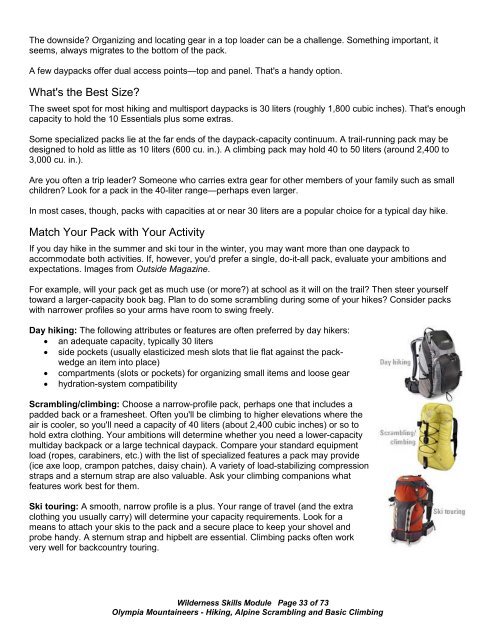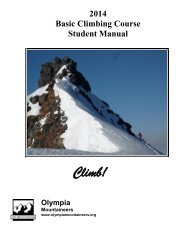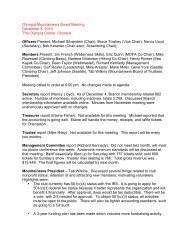Wilderness Skills - Olympia Mountaineers
Wilderness Skills - Olympia Mountaineers
Wilderness Skills - Olympia Mountaineers
Create successful ePaper yourself
Turn your PDF publications into a flip-book with our unique Google optimized e-Paper software.
The downside? Organizing and locating gear in a top loader can be a challenge. Something important, it<br />
seems, always migrates to the bottom of the pack.<br />
A few daypacks offer dual access points—top and panel. That's a handy option.<br />
What's the Best Size?<br />
The sweet spot for most hiking and multisport daypacks is 30 liters (roughly 1,800 cubic inches). That's enough<br />
capacity to hold the 10 Essentials plus some extras.<br />
Some specialized packs lie at the far ends of the daypack-capacity continuum. A trail-running pack may be<br />
designed to hold as little as 10 liters (600 cu. in.). A climbing pack may hold 40 to 50 liters (around 2,400 to<br />
3,000 cu. in.).<br />
Are you often a trip leader? Someone who carries extra gear for other members of your family such as small<br />
children? Look for a pack in the 40-liter range—perhaps even larger.<br />
In most cases, though, packs with capacities at or near 30 liters are a popular choice for a typical day hike.<br />
Match Your Pack with Your Activity<br />
If you day hike in the summer and ski tour in the winter, you may want more than one daypack to<br />
accommodate both activities. If, however, you'd prefer a single, do-it-all pack, evaluate your ambitions and<br />
expectations. Images from Outside Magazine.<br />
For example, will your pack get as much use (or more?) at school as it will on the trail? Then steer yourself<br />
toward a larger-capacity book bag. Plan to do some scrambling during some of your hikes? Consider packs<br />
with narrower profiles so your arms have room to swing freely.<br />
Day hiking: The following attributes or features are often preferred by day hikers:<br />
• an adequate capacity, typically 30 liters<br />
• side pockets (usually elasticized mesh slots that lie flat against the packwedge<br />
an item into place)<br />
• compartments (slots or pockets) for organizing small items and loose gear<br />
• hydration-system compatibility<br />
Scrambling/climbing: Choose a narrow-profile pack, perhaps one that includes a<br />
padded back or a framesheet. Often you'll be climbing to higher elevations where the<br />
air is cooler, so you'll need a capacity of 40 liters (about 2,400 cubic inches) or so to<br />
hold extra clothing. Your ambitions will determine whether you need a lower-capacity<br />
multiday backpack or a large technical daypack. Compare your standard equipment<br />
load (ropes, carabiners, etc.) with the list of specialized features a pack may provide<br />
(ice axe loop, crampon patches, daisy chain). A variety of load-stabilizing compression<br />
straps and a sternum strap are also valuable. Ask your climbing companions what<br />
features work best for them.<br />
Ski touring: A smooth, narrow profile is a plus. Your range of travel (and the extra<br />
clothing you usually carry) will determine your capacity requirements. Look for a<br />
means to attach your skis to the pack and a secure place to keep your shovel and<br />
probe handy. A sternum strap and hipbelt are essential. Climbing packs often work<br />
very well for backcountry touring.<br />
<strong>Wilderness</strong> <strong>Skills</strong> Module Page 33 of 73<br />
<strong>Olympia</strong> <strong>Mountaineers</strong> - Hiking, Alpine Scrambling and Basic Climbing




